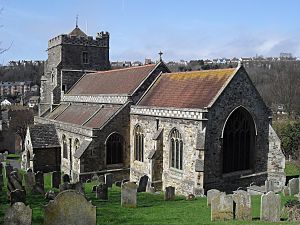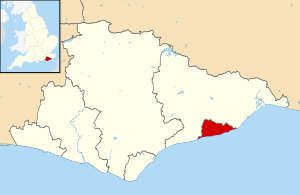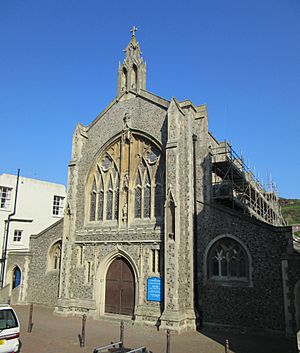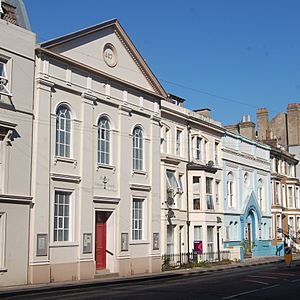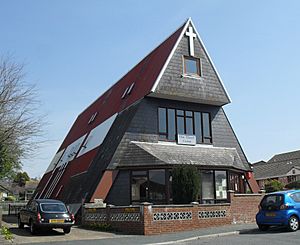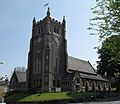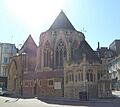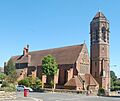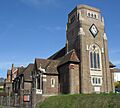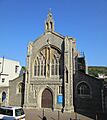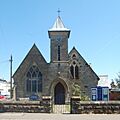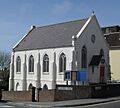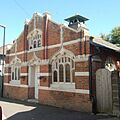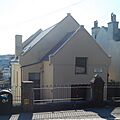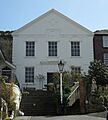List of places of worship in Hastings facts for kids
The town of Hastings, located in East Sussex, England, is home to many different places of worship. There are 50 active churches and other religious buildings, serving various faiths. Another 30 buildings used to be places of worship but are now closed or used for other things. Hastings includes the old port town, the nearby planned town of St Leonards-on-Sea (which joined Hastings in 1888), and newer areas like Ore and Hollington. As these areas grew, especially in the 1800s and 1900s, many new churches were built.
Most people in Hastings identify as Christian. You'll find churches from many different Christian groups here. The largest group is the Church of England, which is the official church of the country. There are also many Roman Catholic churches and Protestant churches, often called Nonconformist. St Leonards-on-Sea also has a mosque for Muslim worshippers. As Hastings expanded into new suburbs, new churches were built there. This helped replace some older churches that closed in the town centre.
Many church buildings in Hastings, both old and new, have been given "listed status" by Historic England. This means they are special because of their history or unique design. There are three levels of listed status:
- Grade I: These buildings are of "exceptional interest" – they are very important and rare.
- Grade II*: These are "particularly important buildings" – more than just special.
- Grade II: These are buildings of "special interest" – still important, but more common than Grade I or II*.
Contents
Hastings: A Town of Many Faiths
Hastings is a seaside town on the southeast coast of England, facing the English Channel. In 2011, about 90,254 people lived here. Hastings is most famous for the Battle of Hastings in 1066. In this battle, William the Conqueror's army defeated King Harold II. But the town's recorded history goes back much further, possibly to the 400s. By 928, it was important enough to have its own mint for making coins.
By the 1100s, Hastings was a main member of the Cinque Ports, a group of important coastal towns. Its castle stood high above the old settlement. In 1291, there were seven churches in Hastings. However, the town faced tough times in the 1300s, including two attacks by the French. By 1801, only two of the original churches, All Saints and St Clement's, were still standing.
Fishing has always been a big part of Hastings' story. Fishermen even had their own church from 1854 until World War II. The old St Nicholas' Church is now the Hastings Fishermen's Museum. In the early 1800s, Hastings started to focus more on tourism and holidays. People enjoyed sea bathing and walking along the seafront. A new town called St Leonards-on-Sea was built next to Hastings, which made Hastings grow even more.
The population grew quickly, from about 3,000 people in 1801 to over 6,000 in 1821. This meant more churches were needed. The first new Anglican church outside the old town was St Mary-in-the-Castle in 1824. By the end of the 1800s, 27 new churches had been built in Hastings and St Leonards-on-Sea. Some were for wealthy visitors, while others were built to help working-class families.
In 1897, nearby villages like Ore and Hollington became part of Hastings. These areas kept their old churches and gained new ones. For example, Ore's 12th-century St Helen's Church became a ruin, but a new one was built nearby, along with Christ Church. Hollington's 13th-century church in the middle of a wood was also joined by a second Anglican church as the village grew into a large council estate.
Christian Churches in Hastings
Anglican Churches: From Old to New
The Church of England has many churches in Hastings. The two oldest surviving churches are All Saints and St Clement's, both in the Hastings Old Town. These churches have been around for centuries and have seen many changes in the town. As Hastings grew in the 1800s, new Anglican churches were built to serve the increasing population. These include Holy Trinity Church and St Matthew's Church. Many of these newer churches were designed in the popular Gothic Revival style, which looked back to medieval church designs.
Catholic and Protestant Communities
The Roman Catholic community in Hastings started holding public services in 1848. Later, in the 1880s, permanent Catholic churches opened. These include the tall and detailed St Mary Star of the Sea Church in Hastings and the Church of St Thomas of Canterbury and English Martyrs, St Leonards-on-Sea in St Leonards-on-Sea. As Hollington grew, the Church of the Holy Redeemer was built there in 1934. Some Catholic chapels in other areas have since closed.
Hastings also has many Nonconformist places of worship. These are Protestant churches that are not part of the Church of England. Early on, it was sometimes difficult for them to build churches. For example, the first Congregational chapel had to be built elsewhere and brought to Hastings by sea!
Baptist churches appeared early, with Ebenezer Chapel opening in 1817. Another Baptist church opened in Wellington Square in 1838. Today, St Leonard's Baptist Church has been serving people since 1882. Many Congregational churches later joined to form the United Reformed Church in 1972. Some of these, like Clive Vale United Reformed Church, are still open today.
Methodist churches have a long history in Hastings too. In the mid-1900s, there were several Methodist chapels. Today, only a few remain open, such as the Calvert Memorial Methodist Church and St Leonards-on-Sea Methodist Church. Many older Methodist buildings have been converted for other uses.
Other Faiths and Groups in Hastings
Various other religious groups have places of worship in Hastings. Different Brethren groups have been active since the early 1900s, meeting in places like Alexandra Chapel.
Quakers and Unitarians have meeting houses close to each other on South Terrace, built in the 1860s. The Salvation Army has been in Hastings since the 1880s, with two main centres.
Other groups with churches or meeting halls include Spiritualists, Seventh-day Adventists, and Jehovah's Witnesses. There are also Elim Pentecostal churches and other Pentecostal groups. Latter-day Saints and Christian Scientists also had buildings, though some have since changed use.
Many Evangelical and non-denominational churches exist, such as The Tabernacle and The King's Church. Some have taken over former Anglican church buildings, like Sonrise Church. The former St Mary Magdalene's Anglican church is now St Mary Magdalene's Greek Orthodox Church. A building in St Leonards-on-Sea was turned into a mosque for Muslims in the 1980s.
Who Lives in Hastings? Religious Beliefs
The 2011 UK Census collected information about people's religious beliefs. Out of about 90,254 people living in Hastings:
- About 51.9% said they were Christian.
- About 1.3% were Muslim.
- About 0.5% were Buddhist.
- About 0.5% were Hindu.
- About 0.2% were Jewish.
- About 0.04% were Sikh.
- About 0.7% followed another religion.
- About 36.6% said they had no religion.
- About 8.3% did not state their religion.
Compared to England as a whole, Hastings had a slightly lower percentage of Christians. However, it had a higher percentage of people who said they had no religious affiliation. It also had more Buddhists and followers of "any other religion" than the national average.
Images for kids
See also


